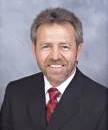
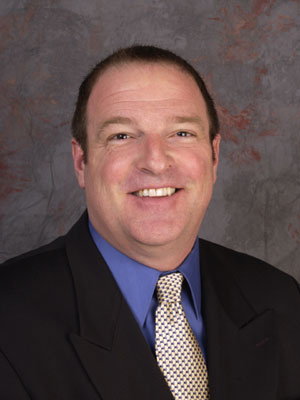
Become A Hero To LB Animals With A $15 Membership. Learn About Us, Click Here.

Saving Lives Thru Spay/Neuter & Education


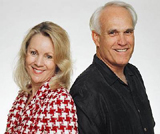


3853 Atlantic Ave.
|
Click here |
Scientists @ LB Conference Present Evidence Indicating Current Levels Of Air Pollution in L.A.-LB Region are High Enough to Cause Illness and Deaths, Call for Reductions In Pollution at LA/LB Ports; Economist Says Ports Receive Subsidies That Invite More Growth
(Feb. 28, 2005, w/ additions Mar 2-23) -- A two-day conference in LB has heard evidence that levels of air pollution currently experienced in the L.A.-LB region are associated with illnesses and deaths, while the LB-L.A.Ports simultaneously receive taxpayer subsidies that conceal their true costs and encourage further growth.
Dr. Peters added, "The current air we are breathing is damaging humans of all ages...No Net Increase [in pollution] is not enough. We need to improve our air quality however we're going to do it." (To hear Dr. Peters' presentation, click here.).
NIEHS, whose mission is to reduce the burden of illness from environmental causes, funds university research centers including the Southern California Environmental Health Sciences Center.
(To hear Dr. Olden's presentation, click here.). [Temporarily unavailable due to server capacity constraints] However Ports also generate significant problems. They are in noise pollution, traffic congestion, safety issues and land use issues...
...Absolutely, there are hundreds of thousands of jobs in the neighborhood, maybe 300,000 jobs in Los Angeles that are affiliated with the Ports. And what that number means, if the Ports were to suddenly disappear, those folks would be unemployed. But it doesn't mean that if the Ports never existed, there would be 300,000 fewer jobs in Los Angeles, because other economic activities would come in and replace the economic activities of the Ports.
And part of the reason that the Ports are here and generating so many jobs is because you all subsidize them. The Ports are tremendous polluters. By their own admission, they're responsible for about 25% of diesel emission in the L.A. area. These emissions are equivalent to those from about 1 million cars.
The region is heavily impacted to the tune of about $2.5 billion in externalized health care costs a year. Now $2.5 billion is a very large number, but I would argue that a number you really should use in this calculation is much larger still, because this number doesn't take into consideration the effects on the individuals. It doesn't take into consideration the lost time off from work. It doesn't into consideration the discomfort, the unhappiness. It doesn't take into consideration early death that sometimes result.
But I'm going stick with the $2.5 billion number because it's big enough to make the point, and the point is that this is a subsidy to goods movement of about $7,000 per job. $7,000 per job I think is enough to attract nearly any industry to the local area.
But certainly what it's doing for goods movement is it's encouraging more goods movement activity than would otherwise be the case...
...The demand for the resource that is willing to pay the most for it ought to get it. That's a simple economic principle that leads to basic economic efficiency provided prices reflect the true cost.
Air is another matter. Here the principle also holds that the use that can pay the most for it ought to get it, but the use that's getting it is not paying for it. So here's an example where price does not reflect the cost. The goods movement industry is using it for free and that costs all of you to the tune of about $7,000 per job...
...Think about what happens in the event that we don't support Port growth, and we don't develop the infrastructure that's really necessary for the Ports to grow from 12 million to 36 million TEUs. I don't think that there's any disagreement that the infrastructure that's currently in place will not allow the Ports to grow from 12 million to 36 million.
But what happens if we decide that that's OK? I'll put forward five different things that I think will happen.
One is that some of the cargo vessels that are currently calling on the Ports will divert to other Ports, will divert to the Port of Oakland and other points along the western seaboard...
And second, what happens if you don't build the infrastructure, better use will be made of existing resources...The Alameda Corridor is looking at short haul train shuttles. And what these train shuttles will do is containers will come off the ships, they'll go right on the bed of a train and get hauled out of the Port. This reduces congestion in the Port. It reduces the amount of time that trucks have to idle in the Port...and it's also likely to reduce congestion significantly.
Third, other ports will invest in capacity, and as other ports invest in capacity, we'll see that diversion becomes even easier away from the Port of Los Angeles and Long Beach...
Fourth, prices of goods movement services will rise, and there's already a lot of this going on...
Finally, less trade will flow. This sounds like a bad thing but I'm going to suggest that it's not entirely. Goods movement is heavily subsidized by you all, by the building of highways and bridges. If we build a $5 billion expansion of the 710, that's a subsidy to the goods movement industry to the extent that the Ports, the shippers and the carriers don't contribute to its construction.
So we've got direct subsidies in infrastructure at home, and infrastructure abroad, the Chinese are building ports like it's nobody's business. They're also subsidizing their carriers, which means that moving stuff from China to the United States is much cheaper than it otherwise would be...
Now I'll make the argument that trade is only economically efficient if prices reflect the costs, and with these subsidies, the prices of moving goods from Asia to the United States do not reflect the true costs, the prices are much lower. If the prices were higher, there would be less trade.
I'm an international trade economist, well indoctrinated in the school of 'trade is good.' But trade is not that good. It's not good enough so that we should be paying people to engage in it.
And just to sum up, where I stand now is basically the following. I don't think that the business as usual approach to trade growth is economically efficient, and it's not going to be able to survive the test of expansion from 12 to 13 million containers.
Economic efficiency with this industry results from taxing it rather than subsidizing it. Why is that? Well, because of the pollution. Common, common principle of public finance economics, that the polluter ought to be taxed to reduce the level of their activities so that the benefits of that activity more equal the costs. We're currently subsidizing the Ports.
And in particular, the local communities, as you all know, subsidize international goods movement through impaired quality of life, whether this means the health effects or the economic effects.
And finally, I do want to point out that the Ports have been historically very important to the development of Los Angeles. The Ports are an important economic driver in the area.
But there are just a great many issues that need to be resolved before it's possible to jump on the bandwagon and say growing from 12 to 36 million TEUs is a really good idea.
To hear economist Haveman's presentation in its entirety, click here.
Dr. Froines said ultrafine particles pose a serious health risk that is only now being appreciated:
...[W]e've done human clinical studies where we've seen changes in heart rate variability and blood pressure, where we've also seen...lung function disturbances; our animal models have seen neurologic inflammation; we have seen heart rate and blood pressure changes; we have seen arrhythmia; and of course we have seen quite strong evidence for airway allergic responses.
In other words, we didn't know about these kinds of end points five years ago, but now it's clear that when you conduct freeway studies, when you conduct studies in close proximity to freeways, that we are seeing a wide range of endpoints associated with particle exposure...
...[M]y point is that we are seeing...new end points that we weren't aware of five years ago. We are seeing these effects at current exposure levels, and we need to be concerned about the adequacy of the regulatory approach that doesn't take into account the products of fossil fuel combustion....We're finding a wide range of end points and we're finding them under conditions that currently exist without any doubt whatsoever. To hear Dr. Froines' presentation, click here.
Barry Wallerstein, D. Env., Executive Officer of the South Coast Air Quality Management District displayed an air pollution measurement strip that, when new, resembled white cheesecloth. He then displayed a strip that had been outside, exposed to LB's air at the AQMD monitor in Bixby Knolls for 24 hours. It was black.
We asked AQMD to provide us with a photo of this...and they did. An AQMD spokesperson said they took care to provide a digital photo that accurately shows it. Its border area (left and top) reflects areas shielded from the LB air. The sample was taken on Dec. 17, 2003.
|
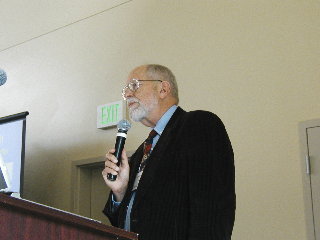 "I emphasize under present conditions, with the air the way it is now, we have more pre-term births and birth defects...We have an increase in asthma and other respiratory disease in children. We have an increase in abnormal lungs in children. We have heart disease in adults. And we have cancer. So that's what's happening with air the way it is," said Dr. John Peters, director of the Southern CA Environmental Health Sciences Center and Prof. of Preventive Medicine at the Keck School of Medicine, USC.
"I emphasize under present conditions, with the air the way it is now, we have more pre-term births and birth defects...We have an increase in asthma and other respiratory disease in children. We have an increase in abnormal lungs in children. We have heart disease in adults. And we have cancer. So that's what's happening with air the way it is," said Dr. John Peters, director of the Southern CA Environmental Health Sciences Center and Prof. of Preventive Medicine at the Keck School of Medicine, USC.
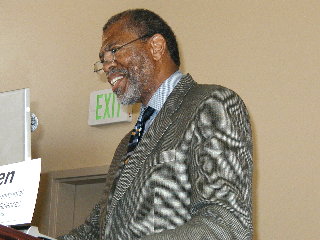 Addressing the conference, Dr. Kenneth Olden, director of the National Institute of Environmental Health Sciences (NIEHS, an institute of the Nat'l Institutes of Health), cited a UC Davis colleague's statement that "Genetics loads the gun, but the environment pulls the trigger." Dr. Olden explained, "[Y]ou may inherit genetic predisposition to have a disease, but never ever have the disease unless exposed to the environmental trigger, so it's the interaction that's important."
Addressing the conference, Dr. Kenneth Olden, director of the National Institute of Environmental Health Sciences (NIEHS, an institute of the Nat'l Institutes of Health), cited a UC Davis colleague's statement that "Genetics loads the gun, but the environment pulls the trigger." Dr. Olden explained, "[Y]ou may inherit genetic predisposition to have a disease, but never ever have the disease unless exposed to the environmental trigger, so it's the interaction that's important."
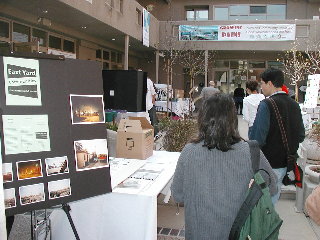 The Feb. 25-26 event -- "Growing Pains: Health and Community Impacts of Goods Movement and the Ports" -- was organized by Southern California Environmental Health Sciences Center, a partnership of USC and UCLA scientists funded by the National Institute of Health Sciences, based at USC's Keck School of Medicine.
The Feb. 25-26 event -- "Growing Pains: Health and Community Impacts of Goods Movement and the Ports" -- was organized by Southern California Environmental Health Sciences Center, a partnership of USC and UCLA scientists funded by the National Institute of Health Sciences, based at USC's Keck School of Medicine.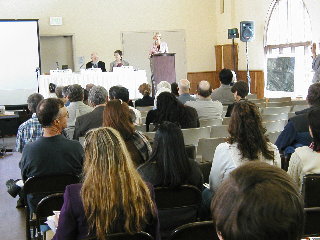 The conference drew nearly 400 people each day to the meeting hall of the First Congregational Church in downtown LB (3d St. @ Cedar Ave.).
The conference drew nearly 400 people each day to the meeting hall of the First Congregational Church in downtown LB (3d St. @ Cedar Ave.).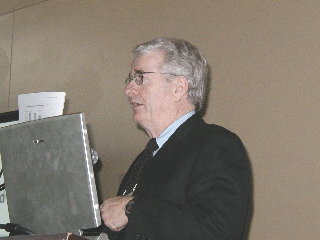 Dr. John Froines, a chemical toxicologist who directs the Center for Occupational and Environmental Health at UCLA and the Southern California Particle Center and Supersite, said studies have shown that ultrafine particles (even smaller than microscopic PM10 and PM2.5) exist at high concentrations along the 710 freeway area near LB.
Dr. John Froines, a chemical toxicologist who directs the Center for Occupational and Environmental Health at UCLA and the Southern California Particle Center and Supersite, said studies have shown that ultrafine particles (even smaller than microscopic PM10 and PM2.5) exist at high concentrations along the 710 freeway area near LB.

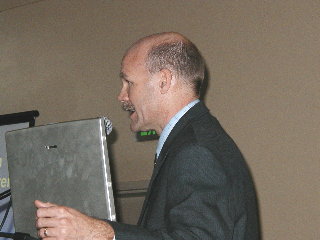 Dr. Jim Gauderman, Associate Professor of Preventive Medicine at USC's Keck School of Medicine, described a newly authored paper on the effects of air pollution on children's lung function. To hear his presentation,
Dr. Jim Gauderman, Associate Professor of Preventive Medicine at USC's Keck School of Medicine, described a newly authored paper on the effects of air pollution on children's lung function. To hear his presentation, 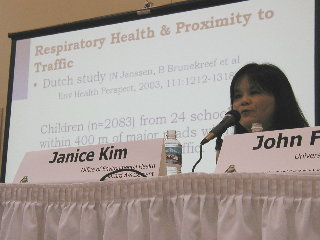 Dr. Janice Kim, a pediatrician with the Office of Environmental Health Hazard Assessment of the CalEPA, described studies on the effects of living close to busy roads and freeways. To hear her presentation,
Dr. Janice Kim, a pediatrician with the Office of Environmental Health Hazard Assessment of the CalEPA, described studies on the effects of living close to busy roads and freeways. To hear her presentation, 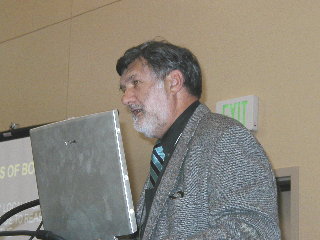 Dr. Thomas Mack, Prof. of Preventive Medicine at USC's Keck School of
Medicine, who recently published Cancers in the Urban Environment -- Patterns of Malignant Disease in Los Angeles County, discussed new findings -- still being analyzed --
related to the still-unexplained larger than expected number of
oropharyngeal (mouth and throat) cancers along the 710 freeway in LB.
Dr. Thomas Mack, Prof. of Preventive Medicine at USC's Keck School of
Medicine, who recently published Cancers in the Urban Environment -- Patterns of Malignant Disease in Los Angeles County, discussed new findings -- still being analyzed --
related to the still-unexplained larger than expected number of
oropharyngeal (mouth and throat) cancers along the 710 freeway in LB.
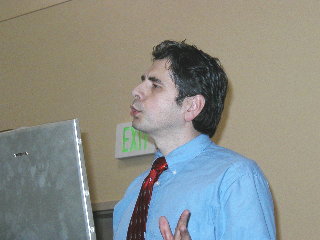 Dr, David Diaz-Sanchez, Assistant Prof. in the Dept. of Medicine at UCLA, has conducted research focusing on the role of the environment in affecting immune responses. He's interested in the role of combustion products (such as diesel exhaust in exacerbating or initiating allergies. [Audio coverage of this presentation is being transferred to new extended capacity server.]
Dr, David Diaz-Sanchez, Assistant Prof. in the Dept. of Medicine at UCLA, has conducted research focusing on the role of the environment in affecting immune responses. He's interested in the role of combustion products (such as diesel exhaust in exacerbating or initiating allergies. [Audio coverage of this presentation is being transferred to new extended capacity server.]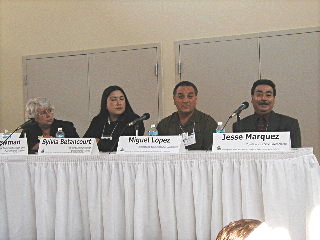
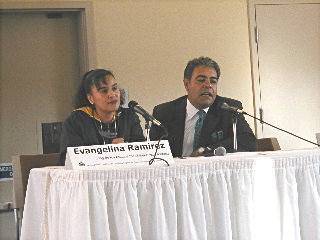
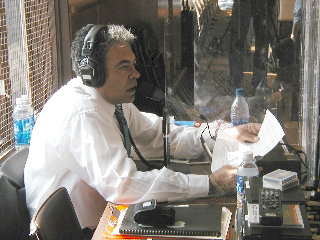 The proceedings were simultaneously translated into Spanish using wireless headsets.
The proceedings were simultaneously translated into Spanish using wireless headsets.
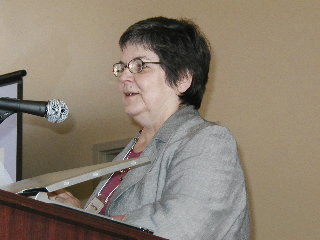 Prof. Andrea Hricko, Associate Professor of Preventive Medicine at USC's Keck School of Medicine and director of the Community Outreach and Education Program at the Southern CA Environmental Health Sciences Center, was a primary organizer of the event.
Prof. Andrea Hricko, Associate Professor of Preventive Medicine at USC's Keck School of Medicine and director of the Community Outreach and Education Program at the Southern CA Environmental Health Sciences Center, was a primary organizer of the event.
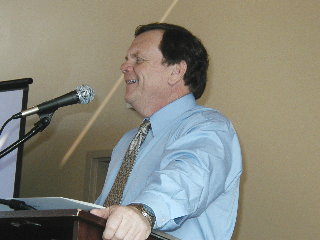 Mr. Tamminen, the founder of Santa Monica Baykeeper and a former director of Environment Now, said the conference's subject matter is important to him.
Mr. Tamminen, the founder of Santa Monica Baykeeper and a former director of Environment Now, said the conference's subject matter is important to him.
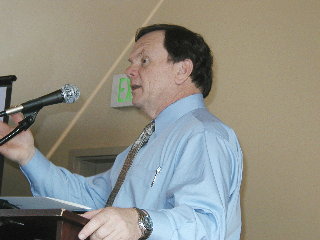 Mr. Tamminen:: ...I was a fan of the bill as it was originally introduced. I thought it had metrics and teeth and potentially good outcomes. The bill that came to the Governor's desk, in my view and in the Governor's view, would not have reduced an ounce of pollution.
Mr. Tamminen:: ...I was a fan of the bill as it was originally introduced. I thought it had metrics and teeth and potentially good outcomes. The bill that came to the Governor's desk, in my view and in the Governor's view, would not have reduced an ounce of pollution.